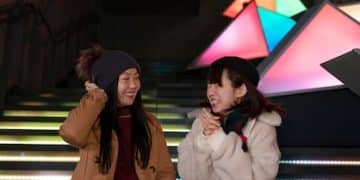K-Pop Vocal Techniques: A Guide to Unique Artist Styles

K-Pop vocal techniques encompass a diverse range of styles and approaches, each contributing to the unique sound and artistry of individual performers and groups, showcasing a blend of technical skill, emotional expression, and stylistic innovation.
Dive into the captivating world of K-Pop and explore the intricate vocal techniques that set its artists apart. From powerful belting to delicate falsetto, understanding these techniques will deepen your appreciation for the artistry and skill behind your favorite songs. We’ll explore K-Pop vocal techniques identifying the nuances that make each artist’s style unique.
Understanding K-Pop Vocal Basics
K-Pop’s vocal landscape is a vibrant mix of influences, blending traditional Korean musical elements with Western pop sensibilities. At its core, K-Pop vocal training emphasizes a strong foundation in vocal technique, breath control, and pitch accuracy. This section breaks down these basics.
Breath Control and Support
Proper breath control is the bedrock of any strong vocal performance. K-Pop vocalists undergo rigorous training to master diaphragmatic breathing, ensuring they can sustain notes, execute complex vocal runs, and maintain consistent tone across their vocal range.
Pitch Accuracy and Intonation
In a genre that demands precision and perfection, pitch accuracy is paramount. Vocalists work tirelessly to develop their ear training and intonation, ensuring that they hit every note with pinpoint accuracy, creating harmonies that are tight and pleasing to the ear.
- Diaphragmatic Breathing: Using the diaphragm for breath support allows for longer sustain and controlled vocal delivery.
- Vocal Warm-ups: Essential for preparing the vocal cords and preventing strain during performances.
- Ear Training: Developing the ability to recognize and reproduce pitches accurately.
Ultimately, the mastery of these basics allows K-Pop artists to build a foundation upon which they can explore more advanced techniques and develop their distinctive vocal colors.
Vocal Range and Types in K-Pop
Understanding vocal range and types provides valuable insight into the capabilities and styles of K-Pop singers. Determining an artist’s vocal range helps understand the kind of music they are best suited for. Vocal types can range from Soprano to Bass.
Defining Vocal Range
Vocal range refers to the span of notes that a singer can comfortably and consistently produce. This range is determined by the physical characteristics of the vocal cords and the singer’s vocal training. Knowing the vocal range enables producers to best make music tailored to the singer’s strengths.
Common Vocal Types in K-Pop
While not strictly defined by classical vocal classifications, K-Pop vocalists often fall into certain archetypes. There are vocal types that can be categorized based on tonal qualities, agility and range.

- Soprano : Typically females with very high ranges.
- Tenor : Usually males with high vocal ranges that can hit high notes powerfully
- Alto: Typically females with low to mid range vocal capabilities
Ultimately, understanding vocal ranges and types provides listeners with a framework for understanding the technical capabilities and stylistic choices of their favorite K-Pop artists.
Belting and Power Vocals
Belting is the core strategy for power vocals in K-Pop. It is a vocal technique that allows singers to project a strong, sustained sound in their higher register, often used during emotionally charged moments or to create a climactic effect in a song. This technique requires a high level of technical skill and vocal control.
The Mechanics of Belting
Belting involves a complex interplay of breath support, vocal cord positioning, and resonance. A strong and stable airflow from the diaphragm is essential to support the vocal cords as they vibrate at a high frequency. Singers also learn to manipulate their vocal tract.
Famous Examples of Belting in K-Pop
Many K-Pop vocalists use belting to create powerful sounds in their registers. Well known artists that are recognized to belt in songs are:
- Ailee
- Wendy (Red Velvet)
- Solar (Mamamoo)
To summarize, belting is a powerful expressive technique that showcases strong breath control and vocal cord positioning. This contributes to the emotional and impactful delivery that K-Pop fans often appreciate and recognize. Belting is essential for projecting power and drama.
Vocal Agility: Runs and Riffs
Vocal agility, as demonstrated through runs and riffs, is a hallmark of many K-Pop vocal performances. Runs are sequences of notes sung quickly and smoothly, while riffs are more elaborate and ornamented melodic patterns. These techniques require excellent breath control, pitch accuracy, and coordination.
Executing Vocal Runs
To execute vocal runs effectively, singers must possess the ability to move seamlessly between notes, both rapidly and accurately. Training often involves practicing scales, arpeggios, and vocal exercises that focus on improving dexterity and coordination. Singers also train their ear in order to precisely identify and transition from one note to others.
Adding Riffs and Ornamentation
Riffs add complexity and flair to a vocal line, showcasing the singer’s creativity and stylistic preferences. Riffs are complex melodic patterns that incorporate embellishments and variations. Some singers are known for being able to create interesting melodies out of existing melodies when riffing.

- Scales and Arpeggios: Consistent practice builds the foundation for accurate and smooth runs.
- Improvisation Exercises: Encourages creativity and spontaneity in riffing.
- Active Listening: Analyzing and adapting riffs from diverse musical genres.
In the end, vocal agility, manifested via runs and riffs, adds a level of virtuosity and excitement to K-Pop songs, allowing singers to showcase their technical prowess and artistic expression.
Emotional Delivery and Vocal Color
Beyond technical skill, emotional delivery and vocal color play vital roles in a vocalist’s ability to connect with their audience. Vocal color refers to the unique timbre and quality of a singer’s voice, influenced by factors such as resonance, vibrato, and articulation. Emotion and vocal color allow songs to evoke emotions in listeners, something that K-Pop utilizes.
Conveying Emotion Through Voice
A skilled vocalist can use their voice to convey a wide range of emotions, from joy and excitement to sadness and anger. This involves manipulating various aspects of their vocal delivery, such as dynamics, phrasing, and tone. Emotional connection is critical because it allows listeners to connect to the music.
Developing a Unique Vocal Color
Vocal color is what sets one singer apart from another. This can be achieved through careful attention to vocal technique, experimentation with different styles and genres, and a willingness to explore the full potential of one’s voice. Distinct vocal qualities help singers stand out from other singers.
Ultimately, emotional delivery and vocal color are elements to captivate listeners. Emotional delivery and vocal color can transform a technically proficient performance into a memorable and emotionally resonant experience.
Unique Vocal Styles of K-Pop Artists
K-Pop is filled with lots of artists, thus there are many unique vocal styles. Each artist brings a distinct vocal style to the genre, shaped by training, personal preferences, and creative choices. Exploring these unique styles can deepen your understanding and appreciation of K-Pop’s artistic diversity.
Analyzing Individual Techniques
Differences in vocal style can range from a singer’s approach to belting to the way they perform runs. Microscopic analysis of their songs and performances can provide insights into what makes their output unique. These analyses can range from vocal tone, key, and delivery styles.
Case Studies of Notable Vocalists
Many K-Pop artists excel at distinct vocal styles. Here are a few case studies of remarkable singers.
- Taeyeon (Girls Generation)
- Baekhyun (EXO)
- IU
In conclusion, vocal style diversity is present in K-Pop as singers continue to diversify what the genre can be. Vocal styles vary widely, which can be attributed to creative choice, training, experience, and preference.
| Key Point | Brief Description |
|---|---|
| 🎤 Vocal Basics | Foundation in breath control, pitch accuracy, and vocal technique. |
| ✨ Belting | Technique for projecting a strong, sustained sound at higher ranges. |
| 🎶 Vocal Agility | Ability to execute rapid note sequences smoothly. |
| 🎨 Vocal Color | Unique timbre, tone, and emotional content of a vocalist’s sound. |
Frequently Asked Questions
▼
Belting is a skill in vocal music where powerful vocal sustain is maintained at higher ranges, producing an engaging sound. It is often used at key expressive points.
▼
Vocal agility in the context of voice is a skill in quickly and smoothly moving between notes. It contributes to the sophistication and technical aptitude of a musical performance.
▼
Vocal color is important because it gives each singer’s output a memorable signature. It also gives a singer the ability to connect with their audience in K-Pop.
▼
K-Pop singers learn to belt through techniques like vocal warmups, breath control, and scales. Over time, practicing these vocal exercises leads to power and vocal strength to hit those belting notes.
▼
Vocal runs and riffs are often used in R&B, soul, and pop music to convey the voice’s range and dynamism. K-Pop takes inspiration from these genres, using vocal runs as well.
Conclusion
In conclusion, K-Pop vocal techniques showcase a diverse and nuanced approach to singing, blending technical precision with artistry and emotional expression. Identifying and appreciating these techniques allows fans to have a deeper understanding of the artistry behind their favorite K-Pop artists.





